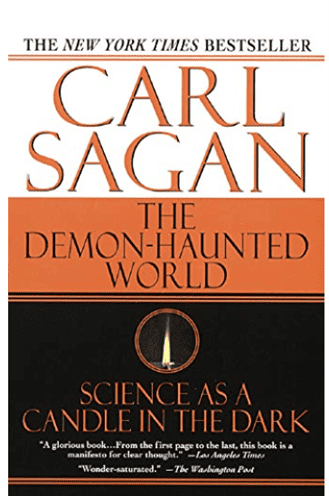By Jim Heffernan
This is a book I first read in 2017 and I was reminded of it when I found a sign I made years ago about being bamboozled.* I was amazed how topical the book was in 2017 (22 years after publication) and how topical it remains today.
Carl Sagan and Ann Druyan wrote this book in 1995 as a response to the burgeoning popular beliefs in such things as astrology, the power of crystals, alien abduction, clairvoyance, the lost kingdom of Atlantis, and many other doubtful beliefs. He felt too many people were rejecting the hard and clear-eyed view of science for what made them feel good.
I thought I would re-read the book, but its length intimidates me a little. Maybe I’m just a little too attached to wanting new ideas. I settled on re-reading Chapter 12, “The Baloney Detector” and perusing the quotations in Goodreads.com. I think that if he’d lived a little longer**, Carl and Ann might have edited the length to make the book a little less repetitive. I still find I can open the book almost anywhere and be intrigued by what he has to say. I only wish he hadn’t talked about so many types of doubtful doctrines.
For me, the highlight of the book is Chapter 12 where he describes 20 ways in which false narratives proliferate. Here’s the Wikipedia summary, in the book each item is discussed in greater detail.
1. Ad hominem. An arguer attacks the opposing arguer and not the actual argument.
2. Argument from authority. Someone expects another to immediately believe that a person of authority or higher knowledge is correct.
3. Argument from adverse consequences. Someone says that something must be done a certain way or else there will be adverse consequences.
4. Appeal to ignorance. One argues a claim in that whatever has not been proved false must be true, and vice versa.
5. Special pleading. An arguer responds to a deeply complex or rhetorical question or statement by, usually, saying “oh you don’t understand how so and so works.”
6. Begging the question. An arguer assumes the answer and makes a claim such as, this happened because of that, or, this needs to happen in order for that to happen.
7. Observational selection. Someone talks about how great something is by explaining all of the positive aspects of it while purposely not mentioning any of the negative aspects.
8. Statistics of small numbers. Someone argues something by giving the statistics in small numbers, which isn’t very reliable.
9. Misunderstanding of the nature of statistics. Someone misinterprets statistics given to them.
10. Fallacy of inconsistency. An arguer is very inconsistent in their claims.
11. Non sequitur. This is Latin for “it doesn’t follow.” A claim is made that doesn’t make much sense, such as “Our nation will prevail because God is great.”
12. Post hoc ergo propter hoc. Latin for “it happened after, so it was caused by.” An arguer claims that something happened because of a past event when really it probably didn’t.
13. Meaningless question. Someone asks a question that has no real meaning or doesn’t add to the argument at all.
14. The excluded middle. An arguer only considers or mentions the two opposite extremes of the conversation and excludes the aspects in between the two extremes.
15. Short-term vs. long-term. A subset of the excluded middle, but so important it was pulled it out for special attention.
16. Slippery slope, related to excluded middle (e.g., If we allow abortion in the first weeks of pregnancy, it will be impossible to prevent the killing of a full-term infant. Or, conversely: If the state prohibits…)
17. Confusion of correlation and causation. The latter causes the former
18. Straw man. Caricaturing a position to make it easier to attack. This is also a short-term/long-term fallacy
19. Suppressed evidence, or half-truth.
20. Weasel word. Talleyrand said: “An important art of politicians is to find new names for institutions which under old names have become odious to the public.”
I do recommend the book to those who have not experienced its joys before. As always, discussion is welcome at codger817@gmail.com.
435 Pages, Published January 1, 1995
Available at: Cloud and Leaf Bookstore, Manzanita, Tillamook Public Library, booksellers
Goodreads 4.28 out of 5, 69,915 ratings.
* “One of the saddest lessons of history is this: If we’ve been bamboozled long enough, we tend to reject any evidence of the bamboozle. We’re no longer interested in finding out the truth. The bamboozle has captured us. It’s simply too painful to acknowledge, even to ourselves, that we’ve been taken. Once you give a charlatan power over you, you almost never get it back.” Page 241
** Carl Sagan died December 20, 1996 after years of suffering from a form of leukemia. He nearly died twice before being diagnosed in 1994. He had three bone marrow transplants.


